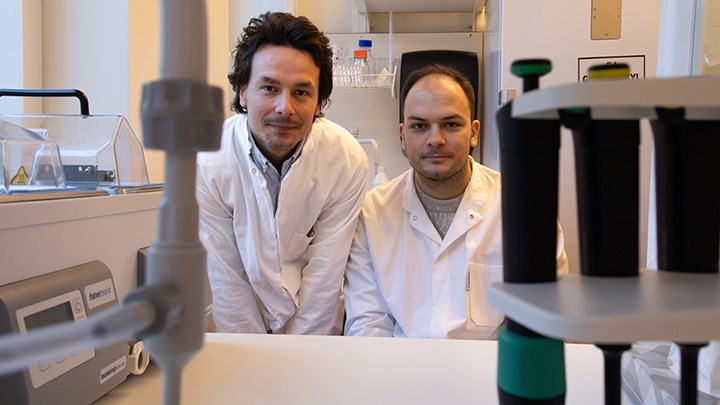Plastic-associated chemicals in electronic waste affect human cells and may cause health risks

“We throw away huge amounts of electronics daily, and the chemicals in this waste could affect human health if they end up in soil and water,” says Andi Alijagic (to the right), here together with co-author Fredric Södergren Seilitz.
Electronic waste such as lamps, computers and mobile phones contain chemicals that can cause endocrine disruption and inflammation in human cells. This is the result of research at Örebro University.
The research results are reported in the article Deciphering the phenotypic, inflammatory, and endocrine disrupting impacts of e-waste plastic-associated chemicals published in the journal Environmental Research..
Hormonal disorders can cause biological effects that interfere with immune, metabolic and reproductive functions.
“We can assume that similar things can happen in humans exposed to e-waste,” says researcher Andi Alijagic.
Mountains of growing waste
Mountains of electronic waste continue to grow as we become increasingly dependent on computers, household appliances, and other products that simplify our everyday lives. Although the importance of recycling metals in these products has long been recognised, there is a lack of research into plastics and other materials in e-waste.
Researchers from Örebro University, Linköping University and the research institute RISE, together with the company Sensor Visions, have studied how chemicals from plastic in electronic waste affect human cells.
The work has been led by Andi Alijagic, researcher in toxicology at Örebro University. His research focuses on the health effects of exposure to particles and chemicals in nano- and microplastics and other plastic-related chemicals.
Cocktail of hazardous chemicals
In a recently published scientific article, researchers report on a cocktail of hazardous chemicals found in electronic waste. The chemical soup includes polyaromatic hydrocarbons (PAHs), organophosphates and phthalates - chemicals widely known to harm human health. PAHs, for example, are the largest group of carcinogens known to man.
To understand how the chemicals affect human health, researchers used an advanced technique called cell painting, where different parts of human cells were painted with fluorescent colours.
“Using advanced microscopy, we can take thousands of images of a cell and compare it to a cell exposed to chemicals from electronic waste. We also analyse the images using CellProfiler software, which detects cellular changes that are too subtle for the human eye,” says Andi Alijagic.
Chemicals impacting cells
Exposure to the chemicals led to significant changes in key cellular structures, such as the cytoskeleton and mitochondria. These changes triggered inflammatory responses in the cells, for example.
“Inflammation is an underlying cause of many diseases. Even low-level inflammation that lasts for a long time can have health effects,” says Andi Alijagic.
The chemicals in the analysed waste were also found to affect hormone signalling, affecting the reproductive health of both women and men.
"We must take care of our waste"
The waste analysed consisted of shredded non-metallic parts from electronic products, primarily plastics with many toxic chemicals. Andi Alijagic believes that the chemicals must be handled when e-waste is recycled.
“We throw away huge amounts of electronics daily, and the chemicals in this waste could affect human health if they end up in soil and water,” says Andi Alijagic.
The researchers’ next step is to determine whether human cells behave differently when exposed to individual chemicals than when exposed to a mixture of chemicals.
Text: Mikael Åberg
Photo: Jesper Mattsson
Translation: Jerry Gray
